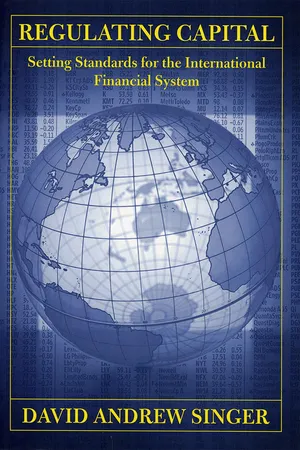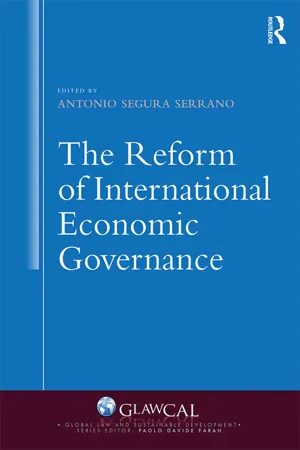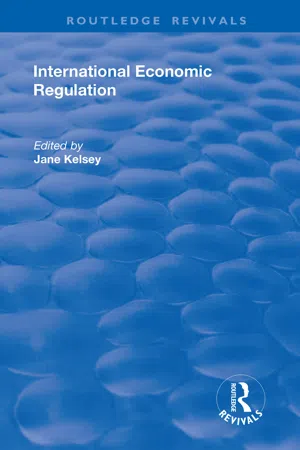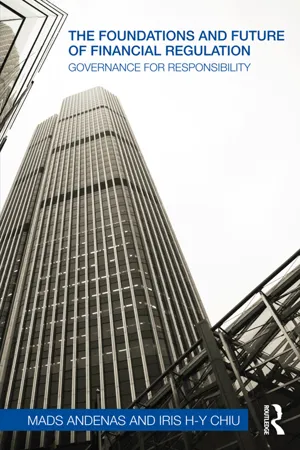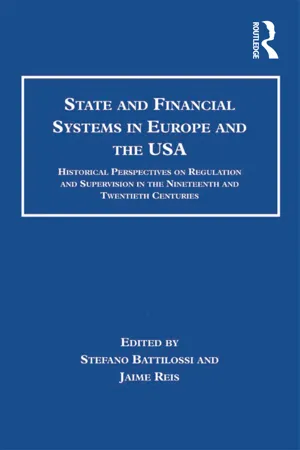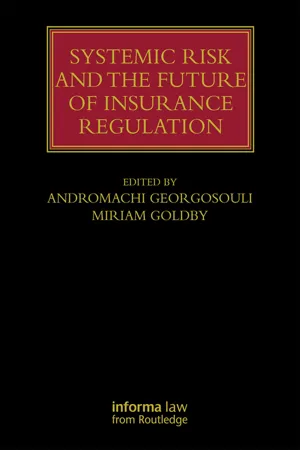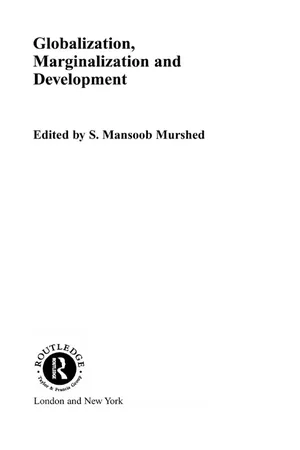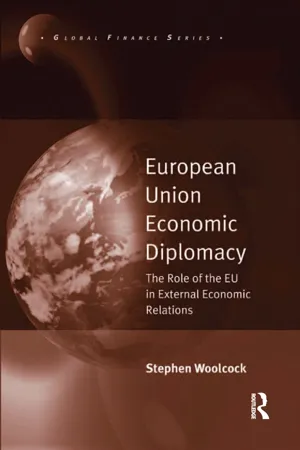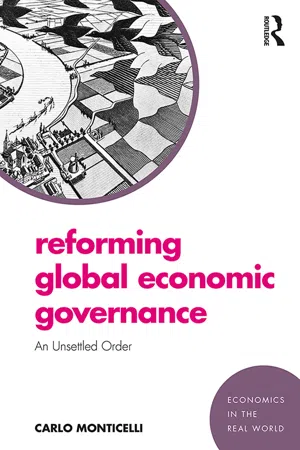Economics
International Financial Regulation
International financial regulation refers to the rules and standards that govern financial activities on a global scale. It aims to promote stability, transparency, and accountability in the international financial system, as well as to prevent financial crises and protect investors and consumers. International organizations such as the International Monetary Fund (IMF) and the Financial Stability Board (FSB) play a key role in developing and implementing these regulations.
Written by Perlego with AI-assistance
Related key terms
Related key terms
1 of 4
Related key terms
1 of 3
12 Key excerpts on "International Financial Regulation"
- eBook - ePub
Cornell Studies in Money
Setting Standards for the International Financial System (Cornell Studies in Money)
- David Andrew Singer(Author)
- 2015(Publication Date)
- Cornell University Press(Publisher)
My focus is on the creation of global standards rather than on international memoranda of understanding that facilitate ad hoc cooperation in areas such as securities fraud and other criminal activity. Substantively, my emphasis is on capital, and therefore on the stability of financial institutions, rather than on consumer protection or the fight against illicit activity. And as should be clear, I focus on the role of public-sector regulatory agencies that have been delegated responsibility by the government rather than on private standard-setting organizations or industry self-regulation. 30 Financial Regulation and International Relations Why study International Financial Regulation? Regulation at the domestic level is often designed to address market failures, in which the unfettered activities of firms and consumers result in unfavorable outcomes. For example, the decentralized decisions of banks and their clients may lead the former to lend too aggressively, thereby putting the stability of the financial sector—and the entire economy—at risk. The prevalence of market failures in domestic financial markets provides incentives for governments to step in, as necessary, by establishing financial regulations. With the globalization of financial markets, market failures have moved to the international level. Examples such as the 1987 stock market crash, which roiled financial markets in New York, London, Tokyo, and throughout the rest of the world, demonstrate that financial instability in one country can affect many other countries that are tied together in the global economy. However, addressing international market failures is not as straightforward as in the domestic case. International Financial Regulation, in short, requires international cooperation - eBook - ePub
- Antonio Segura Serrano(Author)
- 2016(Publication Date)
- Routledge(Publisher)
The redesign of International Financial Regulation – and the main objective of global financial governance – is regulatory challenge posed by the financial crisis will be how regulators and central bankers can strike the right balance between micro-prudential regulation and supervision with macro-prudential controls on the broader financial system and economy. The overriding theme of the international financial reform initiatives (for example, the G20, the Financial Stability Board and Basel Committee) that began with the G20 Summits in Washington DC in November 2008 and London in April 2009 35 has been how to devise effective regulatory frameworks that durably link micro-prudential supervision with broader macro-prudential systemic risk concerns. Indeed, a major reform of global financial governance has been the shift in regulatory and supervisory focus from micro-prudential to macro-prudential regulation. The focus on macro-prudential regulation has involved, for instance, devising regulatory standards to measure and limit leverage levels in the financial system and to require financial institutions to have enhanced liquidity reserves against short-term wholesale funding exposures. Macro-prudential regulation will also involve capital regulation that is counter-cyclical – requiring banks to hold more regulatory capital during good times and permitting them to hold less than what would be usually required during bad times. Counter-cyclical capital requirements would link capital charges to points in the macro-economic and business cycle. For example, this would involve dividend restriction policies during a crisis or recession so that banks will lend more. 36 This will necessarily involve banks using more forward-looking provisions based on expected losses - eBook - ePub
- Jane Kelsey(Author)
- 2018(Publication Date)
- Routledge(Publisher)
Part IIRegulating International Finance and InvestmentPassage contains an image
[5]
Regulating Global Financial Markets
SOL PICCIOTTO* AND JASON HAINES**This paper discusses the role of regulation in the emergence of a global system of linked financial markets. It traces the origins of the internationalization of financial markets to the emergence of new competitive pressures, rooted in changes in the social structures of savings and investment, breaking down both national systems of financial control and international arrangements for monetary and financial co-ordination. These changes have been accompanied and facilitated by a process of international re-regulation, through informal specialist networks. Although these have facilitated the international diffusion of regulatory standards and practices, and attempted to co-ordinate them, they are greatly hampered by espousing the perspectives of the various markets and firms which it is their task to supervise. Together with their minimalist view of the aims of public legitimation and oversight of financial markets, they have proved inadequate to prevent the destabilizing effects of the new global finance on the world economy.This paper greatly benefited from a grant from the Leverhulme Trust to fund research by the authors into Regulation of Globalized Futures Markets. Earlier papers exploring these issues were presented to the Second Consortium on Globalization, Law and Social Sciences, University of Glasgow, June 1996; and the Third Consortium on Globalization, Law and Social Sciences, Institute for Law and Society, New York University, United States of America, April 1997. A draft of this paper was delivered at the W. G. Hart Workshop on Transnational (Corporate) Finance and the Challenge to the Law, Institute for Advanced Legal Studies, University of London, July 1998. We are grateful to the organizers and participants at these workshops for the opportunity to debate the issues, and especially to David Campbell, Kevin Dowd, and Dede Boden for many helpful comments and fruitful discussions, and to the journal's referees for specific suggestions. We would also like to thank the many financial market participants and regulators who have spared some of their valuable time to participate in our continuing research. - Stephany Griffith-Jones, Ricardo Gottschalk(Authors)
- 2016(Publication Date)
- Routledge(Publisher)
2 Financial regulation, stability and growth in low-income countries A review of the evidence and agenda for research Stephen Spratt IntroductionFor many low income countries, especially in Africa, financial regulation policies constitute the foundation basis for the mechanisms through which financial development exerts a positive impact on economic growth and poverty reduction.(Murinde, 2012)Without effective regulation, financial systems become unstable, potentially triggering crises with devastating effects on the real economy. The continuing impacts of the global financial crisis of 2007–8 show how large these can become. While the avoidance of crises is a necessary condition for productive economic activity to flourish, it is not sufficient. Another more positive side to regulation is one which shapes the evolution of financial structures and influences the ways in which financial actors serve the real economy. The purpose of regulation is thus twofold: to maintain financial stability and to promote inclusive economic growth. Achieving the right balance between these objectives is a delicate, but crucial task. Too great a focus on stability stifles growth, while a headlong dash for growth is very likely to sow the seeds of future crises.The structures of low-income countries’ (LICs) real and financial sectors are different to those in developed countries. Institutional capacity to implement certain kinds of financial regulation is also generally lower. Therefore, the set of regulatory instruments best able to maximise growth, while maintaining stability, should also be different.While this has always been broadly accepted in principle – if rarely in practice – the global financial crisis highlighted a more fundamental issue. Given what we learnt about ‘sophisticated’ finance, it is simply no longer tenable to view the regulatory practices that evolved in the world’s major financial centres as a model to which developing countries should aspire. As regulatory options continue to be re-assessed in developed economies, the time is ripe to do the same in developing countries in general, and LICs in particular.- eBook - ePub
The Foundations and Future of Financial Regulation
Governance for Responsibility
- Mads Andenas, Iris H-Y Chiu(Authors)
- 2013(Publication Date)
- Routledge(Publisher)
Hence, the role of regulation in financial markets is framed in the economic language of ‘market failure’, such as in cases of regulation to overcome information asymmetry in securities and investment markets and the ‘agency’ problem between investment intermediaries and clients. 10 The role of financial regulation is also to provide ‘public goods’ such as systemic stability, which underpins micro-prudential regulation and deposit guarantee schemes. 11 Such a role may suggest that the regulatory stance adopted for the purposes of maintaining financial stability is more protective or paternalistic in nature. However, regulation purposed towards maintaining financial stability is also couched in the language of economic rationale, ‘public goods’ being defined as goods that are collectively enjoyed by society, 12 but the provision of which is often subject to a collective action problem, and so the state is ultimately looked to in order to supply it. 13 Regulatory interventions based on economic rationale tend towards being proportionate and favouring efficient solutions that the market can generate. The point of financial regulation is not to assume responsibility for or adversely affect the core intermediation and resource allocation functions of the financial sector. 8 See, for example, Milton Friedman, Capitalism and Freedom (Chicago, IL: University of Chicago Press 1962), chs 1 and 4. See also useful summary of Ioannis Glinavos, ‘Regulation and the Role of Law in Economic Crisis’ (2010) 21 European Business Law Review 539, http://articles.ssrn.com/sol3/articles.cfm?abstract_id=1425782 accessed 12 October 2012. 9 Gerard A Epstein (ed), Financialisation and the World Economy (Cheltenham: Edward Elgar 2006), especially Chapter 1, ‘Introduction’ - eBook - ePub
State and Financial Systems in Europe and the USA
Historical Perspectives on Regulation and Supervision in the Nineteenth and Twentieth Centuries
- Jaime Reis, Stefano Battilossi(Authors)
- 2016(Publication Date)
- Routledge(Publisher)
The next part of the chapter develops the history of prudential regulation and supervision of international banking that began after the end of the Bretton Woods system. This area has remained a challenge for regulators for much the same reasons that were present in the 1970s: problems of enforcement, the privacy of banking business, and the primacy of national over international interests. A second theme of the chapter, therefore, is the enduring conflict between the desire to have national sovereignty over financial markets on the one hand, and the need for supranational oversight to ensure consistency and enforcement of prudential supervision and regulation in an increasingly global market.I
The regulation of international financial markets in the 1950s and 1960s was closely linked to the Bretton Woods solution to the ‘trilemma’ or ‘impossible trinity’, which explains that maintaining policy sovereignty in the context of fixed exchange rates requires imposing limits on international capital flows.1 The over-riding goals of national economic growth and full employment as well as the development of welfare states after 1945 required that national sovereignty was prioritized over freer capital flows.2 Countries with balance-of-payments deficits used direct controls on outflows to avoid relying solely on higher domestic interest rates. Conversely, countries with pressures for surplus and inflation used regulations to protect their domestic monetary systems from inflows of capital.The terms of the Bretton Woods agreement reflected a broad international consensus that freer markets in goods were beneficial for growth, employment and incomes overall, but that international financial markets should be closely regulated.3 While the link between freer trade and growth is fairly well established, there is still no such consensus for the link between liberalization of financial markets and growth. It makes sense to assume that freer capital markets will generate a more efficient global allocation of investment resources and so provide the best prospects for growth. However, empirical research has revealed an ambiguous relationship between capital-account liberalization and economic growth.4 Crafts has observed that there is ‘no evidence that abolishing capital controls per se leads to higher growth …. But there is quite good reason to believe that financial liberalization significantly increases the risk of a subsequent financial/currency crisis’.5 In 1997, the IMF began to consider including capital-account liberalization in its Articles of Agreement, but this process was stalled in the wake of the financial crises of the late 1990s. In December 2003, Anne Kreuger, Director of the IMF, advised that ‘Capital flows are, in some respects, like antibiotics. Anything capable of doing good is also powerful enough to inflict harm when wrongly used. That is not a reason to restrain capital flows, though, but to harness them so that they can do most good’.6 - International Monetary Fund. Legal Dept.(Author)
- 2013(Publication Date)
- INTERNATIONAL MONETARY FUND(Publisher)
In hindsight, neither market participants nor regulators adequately appreciated the risks inherent and embedded in complex financial products, let alone the aggregation of these risks across the system. Supervisors and regulators, who are always behind the markets, were further hindered by their firm-by-firm approach that deprived them of a more encompassing macro perspective of the forces at play.As the crisis broke out in the fall of 2007, the United States put forward an international strategy to tackle the roots of the crisis, which was quickly embraced by the G-7. Our strategy was premised on several realities:- First, regulation is a national activity and the responsibility for sound regulation begins at home.
- Second, today’s financial system is global and financial stress can spread easily and quickly across national boundaries.
- Third, the benefits of dynamic and efficient global financial markets should be preserved while at the same time these markets must be soundly regulated.
- Fourth, the crisis revealed micro- and macroprudential flaws that needed tackling.
So, how did we address these realities? Of course, we do not live in a day and age in which a “global” regulator can be the answer. National regulation is here to stay, but it also should be more consistent and convergent across the globe. Thus, national regulators, working through standard-setting bodies, such as the Basel Committee, IOSCO, and IAIS strengthened their collaboration. Also, the Financial Stability Forum, now Financial Stability Board (FSB), was seen as a critical element of the response and it was expanded to include the entire G-20. The United States has encouraged the FSB to loosely coordinate the activities of the standard setting bodies, while respecting their independence, to ensure that needed reforms to the global financial system are undertaken in a timely manner.But the FSB’s focus is primarily microprudential in nature. The IMF, in contrast, as the world’s central macroeconomic institution, is responsible for bringing a more macroprudential focus to bear in international discussions and we underscored the Fund should be a leader in defining and undertaking this task. Indeed, the growing need for a macro focus to supervision is increasingly evident, as seen in the EU discussion of a European Systemic Risk Board and in the U.S. discussion of a Financial Services Oversight Council.- eBook - ePub
New York's Financial Markets
The Challenges Of Globalization
- Thierry Noyelle(Author)
- 2019(Publication Date)
- Routledge(Publisher)
Thus while financial regulation is necessary to ensure the stability and soundness of the financial system, it invariably generates efficiency losses. At the level of the firm, regulation constrains management's freedom in deploying the institution's capital and human resources, in designing financial and organizational structures, and in developing business strategies. At the level of society, regulation may foster a misallocation of resources, reduced innovation and international competitiveness, and constrain the contribution of the financial system to economic growth. In a dynamic world, national policymakers must continuously monitor the cost-benefit trade-off in financial regulation.International Competitive Impact of Regulation
The preceding section reviewed numerous features of financial regulation and deregulation, both of which may contribute net benefits to society, it will be useful for our analysis in this section to think of financial regulation as a tax on the financial services industry. Two points on applying the infamous "Laffer curve" in this context are clear—with a zero tax rate, there are zero tax revenues (i.e., no safeguards beyond those that the private market provides for itself), and with a 100 percent tax rate, there are also no tax revenues, because no financial services are provided privately. While regulations might be designed to maximize tax revenues, we will argue that this is not an appropriate policy objective. The goal of policy should be to balance the level of regulatory control versus deregulatory freedom in order to optimize the welfare of society—to achieve the highest levels of productive output with acceptable levels of risk emanating from the financial sector.Even within a single economy, the optimal design of financial regulation is a complex matter. Thinking of regulation as a tax, the issue we wish to consider is whether a government will necessarily be able to collect a tax that is "excessive." Regulations (e.g., reserve requirements, capital adequacy requirements, and so forth) impose costs which, in part, will be transferred to clients. - Andromachi Georgosouli, Miriam Goldby(Authors)
- 2017(Publication Date)
- Informa Law from Routledge(Publisher)
103 are now largely made by reference to the security of the global financial system by reference to ‘systemic risk’. The international community has, for the time being at least, largely put aside its concern as to the inevitable interference in their sovereignty as a result.103 The reference to ‘convergence’ is applied here to describe the process whereby, in the context of insurance, each country frames its domestic laws by reference to a common set of standards settled by the IAIS and the G20 (through the FSB) and endorsed by the IMF. By reference to this definition, the laws applied by individual nation states to regulate insurance markets and providers are increasingly functionally substitutional from one country to the next. This does not imply that social and cultural differences will not remain and affect markets nor that every legislative detail will inevitably be harmonized.The objections of insurers notwithstanding, the regulation of insurance continues to be swept along with that of banks. At the international level there are a range of treaty organisations including the United Nations, the World Bank, the IMF and the OECD that have assumed the mantle of ensuring systemic stability. There are also international and regional government groupings including the G20, the G8,G7, the EU, ASEAN and the African Union among others. Those groups have themselves formed bodies such as the FSB.Stepping forward as the guardians of global financial health, the G20 has prescribed enhanced regulatory coordination, cooperation and convergence as the remedy for minimizing ‘systemic risk’. The G20 now seeks to steer the course which financial regulation takes internationally. Along with the IMF it has become a lynchpin of the international financial architecture. Working in tandem with the international organizations, government bodies and groups have formed to identify and mitigate risks to the international financial system. In the view of the G20, ‘effective, robust and consistent global regulation assists in the early detection, and abatement of, potentially serious systemic issues which readily transfers risks across borders and creates global crises such as that witnessed in recent years’. There is little persuasive evidence to support this proposition but it has been accepted as a truth nevertheless across the layers of organizations and groupings each determined to have a role in identifying the sources of systemic risk and the appropriate means of addressing them through regulation.- eBook - ePub
- Mansoob Murshed(Author)
- 2002(Publication Date)
- Routledge(Publisher)
2 Financial sector regulation in a globalized context
S. Mansoob Murshed and Djono SubagjoIn his presidential address to the American Economics Association, Milton Friedman gave us the authoritative version of the monetarist creed:…monetary policy can prevent money itself from being a major source of economic disturbance… A second thing monetary policy can do is to provide a stable background for the economy. Milton Friedman (1968: 12–13)This statement has become the cornerstone of macroeconomic policy advice dispensed to all developing and transitional economies. It also constitutes the raison d’être for the primacy of inflation control, as well as the stabilization and structural adjustment programmes of the 1980s, and the associated liberalization of financial markets. But as we all know, with hindsight, this view (generally described as the Washington consensus) ignored the need for prudential regulation of the financial sector as a prerequisite for sound monetary policy. The converse is equally true: stable monetary policies are needed if an efficient financial sector is to flourish. Simple (or simple-minded) capital account liberalization, as part of a strategy of integration into the global economy, has become discredited in the wake of the Asian crisis of 1997 (see Rodrik 1998). In addition, it is recognized that monetary policy reform geared to controlling inflation will not benefit the economy fully unless and until the private financial sector is well functioning. Also in the presence of many other distortions in the economy, financial liberalization may be undesirable, due to second-best considerations. The over-arching problem lies in the weak nature of institutions and the type of strategic interaction between the state and various groups in developing countries (LDCs).This chapter aims to make a policy-oriented contribution to the literature on prudential bank regulation for LDCs. It does three things: first, it argues that there is a need to place banking sector regulation high on the policy agenda. Second, it provides some theoretical insights, emphasizing the difficulties of the regulation process. Finally, it critically analyses policy advice in a taxonomic style with regard to prudential regulation, paying close attention to the capabilities of lowincome and small LDCs. The first section examines the need to pay attention to banking regulation, the second section is devoted to the theoretical and policy analysis on bank regulation, and, finally, the third section concludes with policy recommendations. - eBook - ePub
European Union Economic Diplomacy
The Role of the EU in External Economic Relations
- Stephen Woolcock(Author)
- 2016(Publication Date)
- Routledge(Publisher)
The approach adopted by the Commission was analogous to that of the Cockfield White paper for goods launched slightly more than 10 years earlier. The FSAP listed 42 measures that were considered necessary to harmonise EU regulatory standards in the financial sector (European Commission, 1999). These measures covered banking, securities, insurance, mortgages and pensions and were intended to help bring about broad equivalence in the national regulatory regimes that was necessary for home country control to function properly. Despite this agreement to work on a list of specific standards/norms, underlying differences remained. As noted above, there were differences between the regulatory ‘cultures’ in the member states. There was also the question of how EU regulatory standards should relate to international regulation. If the EU could develop common EU regulatory standards, it could be expected to have a major influence on international standards (Becht and Correia da Silva, 2007). But some member states, such as Britain, and some interests preferred the international level and feared EU standards would be more restrictive and thus undermine the competitive position of the City of London as a financial market. The approach to financial markets was also shaped by the prevailing mood of the late 1990s, which was one of fatigue with EU level legislation. The sentiment of the member state governments at the time of the Cardiff European Council in 1998 when the Single Financial Market Action plan was adopted, was generally sceptical of the need for greater centralisation and favoured more flexibility.Before very long however, there was recognition that the institutional arrangements for EU decision-making in financial market regulation were not fit for purpose. Financial markets were developing, and new ‘products’ were being introduced that Commission officials could not easily follow. EU legislation on financial regulatory standards was being adopted, but these tended to lag behind the implementation of international agreements by the member states. Thus, new standards would be agreed in the various international bodies such as the BCBS and adopted at the national level before the EU endorsed the same international standard in an EU directive. So the role of the EU in international financial regulatory standards-making was one of a follower rather than a leader. In an attempt to improve and speed up the EU decision-making process as well as bring more clarity into the complex decision-making procedures within the EU, the Commission set up a Committee of Wise Men under the chairmanship of Baron Alexandre Lamfalussy. - eBook - ePub
Reforming Global Economic Governance
An Unsettled Order
- Carlo Monticelli(Author)
- 2019(Publication Date)
- Routledge(Publisher)
half-hearted despite the advantages of regulatory consistency in a world of ever-growing financial interconnectedness. This ambivalence stems from two deep-seated political economy issues that survived the crisis virtually unscathed and heavily influenced policy responses.First, international regulatory cooperation has always been constrained by each country’s objective of defending the actual or perceived interests of its own financial industry, both in protecting the domestic market from foreign penetration and in favouring its expansion abroad.78 Thus, in parallel to their support for the G20 financial reform agenda based on the revamping of the international standards regime, major countries, and most notably the US and the EU as a bloc, sought in various ways to (re)assert their regulatory power towards other jurisdictions, which in turn typically followed the same logic. Efforts to strengthen cooperation and improve cross-country consistency in the implementation of regulatory standards went hand-in-hand with disputes about the terms of access to each other’s markets, the equivalence between domestic rules, and their extraterritorial implications.79
Index pages curate the most relevant extracts from our library of academic textbooks. They’ve been created using an in-house natural language model (NLM), each adding context and meaning to key research topics.
Explore more topic indexes
Explore more topic indexes
1 of 6
Explore more topic indexes
1 of 4
